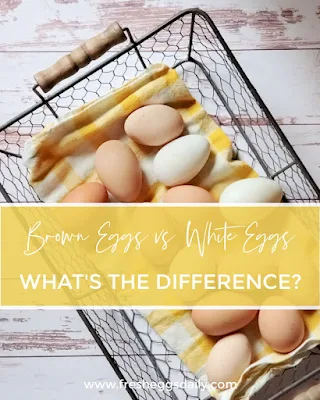Brown Eggs vs. White Eggs | What's the Difference?
in
Eggs,
What's the difference between brown and white eggs? Not much, as you'll learn.
A common question I get a lot is what's the difference between brown eggs and white eggs. But believe it or not, the only difference between brown eggs and white eggs is the shell color.
Not only do they look exactly the same on the inside, the inside of the shells of both brown and white eggs are actually white!
Brown eggs and white eggs (and blue and green eggs too for that matter) taste the same and have the same nutritional value.
The nutrition and taste of an egg is determined by the hen's diet for the most part, and how fresh the egg is, not the shell color.
Brown Eggs vs. White Eggs | What's the Difference?
The different shell colors are actually dictated by breed. All eggshells start out white, then depending on the breed, the shell is either dyed with brown pigment or left white.
The brown color is applied only to the outside surface of the shell near the end of the laying process by certain brown egg laying breeds such as:
- Barred Rock
- Brahma
- Buckeye
- Buff Orpington
- Chantecler
- Cochin
- Delaware
- Dominique
- Java
- Jersey Giant
- Golden Comet/Production Red/Red Star
- New Hampshire Red
- Plymouth Rock
- Rhode Island Red
- Sussex
- Wyandotte
Brown Eggs
Growing up across the street from my grandparent's chicken farm, all we ever ate was brown eggs from their mixed flock of what I believe to have been Rhode Island Reds and Australorps.
As kids, we learned the jingle "brown eggs are local eggs, and local eggs are fresh." Which turned out to not be entirely incorrect, actually.
But I remember often going to friends' houses for sleepovers and seeing white eggs their Moms bought from the super market.
The History of White Eggs
Historically, Leghorn chickens were raised by the commercial poultry farms for egg production because not only are they high-producing layers, due to their very slight body type, they don't eat as much as the larger breeds and therefore are more economical for large-scale operations to keep.
That is to say, it requires less feed (and therefore less cost) to produce one egg, so the commercial farms can keep their profit margins higher.
Leghorns lay white eggs, so store bought eggs were typically white, although there are several other, less common breeds that lay white eggs, including:
- Andalusian
- Belgian D'Uccle
- Campine
- Catalana
- Hamburg
- Lakenvelder
- Leghorn
- Minorca
- Polish
- Russian Orloff
- Sabelpoot
- Sebright
- Sicilian Buttercup
- Silkie
- White Faced Black Spanish
Conversely my grandparents - and other farmers - tended to raise the larger, heavier dual-purpose breeds for both meat and eggs. (Scrawny Leghorns aren't nearly as good eating as a plump Australorp!)
Being larger, they eat more feed, comparatively. They also lay brown eggs. So it became the norm that commercial eggs were white and farm or "peasant" eggs were brown.
The upper class in the cities and urban areas began to think of brown eggs as "lower class" and preferred white eggs. And so white eggs became the predominant eggs being sold to the masses commercially while farm families happily ate their brown eggs.
Brown Eggs are Local Eggs
With the interest in eating fresh, local foods on the rise about a decade ago, brown eggs began to come into favor and be seen as the "healthier" choice in eggs.
The ensuing farm to table movement played a bit role in the rise in popularity in brown eggs, as did the uncovering of various abuses by the commercial chicken industry.
All of a sudden the vision of fat, happy chickens frolicking happily in a pasture became extremely appealing to consumers. Far more than the idea of sad chickens living in cages no larger than a sheet of copy paper.
Grocery stores started stocking brown eggs in cartons labeled "pasture raised" "free range" and "farm fresh" and selling them for a premium. These days it seems that there are more brown eggs than white eggs at our super market!
And they generally sell for two to three times what a dozen of white eggs sells for.
So I guess others have finally learned what we knew all along - that brown eggs are local eggs and local eggs are fresh.
But in actuality, it's all just perception.
What's the Difference?
The reality is that eggs produced by local chickens allowed to roam and eat grass and bugs while they get fresh air and exercise, whether brown or white, are fresher, more nutritious and more delicious.
The color doesn't matter. What matters is how the chickens are raised and treated, and what they are fed. Personally, I don't care what color an egg is. As long as it's fresh. And the chicken who laid it is happy.
Pin This!
Further Reading































